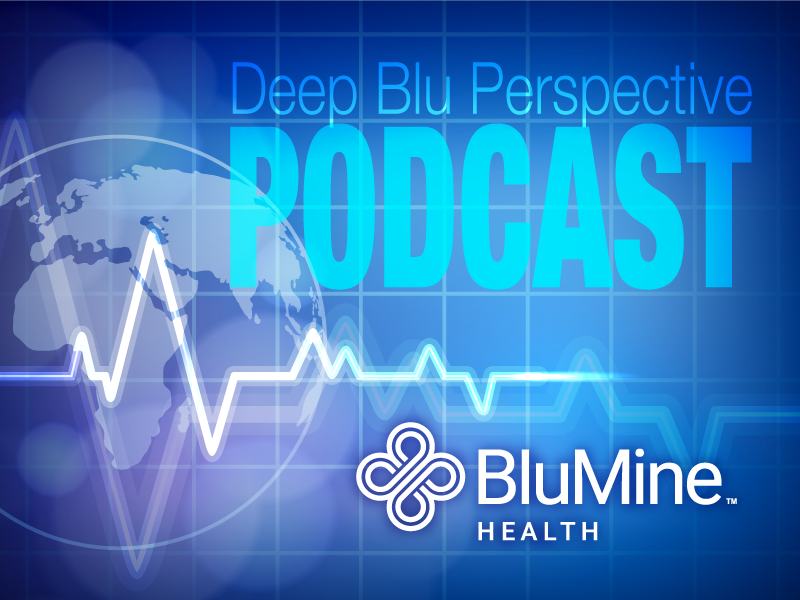
Sharing Tips to Help You Live Healthier and Longer
December 1, 2019Medical News
April 1, 2020BluMine’s Eye On Healthcare: Return To Work Anxiety Tips

Many states are anxiously preparing to reopen to provide much-needed support to our suffering economy. Employers are strategically developing plans to bring employees back to work safely. This includes giving careful thought to schedules, seating configurations, elevator usage, visitor policies, food delivery, and much, much more.
While workforce reentry certainly includes logistical and operational planning, it is not just physical well-being that employers must take into account. Equally important is how organizations will respond to employees’ emotional and psychological health —a topic that, regrettably, is often ignored or at least discussed far less frequently, unfortunately.
Anxiety is universal among all populations right now -- a natural reaction to unnatural circumstances (such as this pandemic) and a somewhat uncertain future because of it! About half of the employees in the United States are concerned if employers will call them back to work before it is safe, according to a national survey by Weber Shandwick and KRC Research. More than 50% of employees worry about the future of the company they work for and specifically their individual job security, also according to the above-mentioned survey.
Employers must prepare for these sources of anxiety and help employees to manage their state of mind or mental health. If they don't take these concerns into consideration, we will never be able to return to the engagement and productivity levels prior to COVID-19. And, the thought lingers for all of us that life as we knew it will never be the same - at work or for life in general.
Most employers will need to enhance current practices, contracting external or third-party mental health programs with a greater capacity to deal with stress, anxiety, and uncertainty “in house.” This does not mean attempting to take the place of trained mental health practitioners but rather building greater internal awareness and sensitivity toward the need to address employee concerns.
Recent research suggests that there are five critical "To-Dos" to help employees feel more comfortable and less stressed about returning from the virtual working world back to the scheduled/routine work environment we once knew as normal.

Use the following FIVE TIPS to assist in developing a new normal for your employees.
- Make employees’ well-being your top priority.
Employees need and want reassurances that their companies are putting them first! This is especially important as this pandemic continues to spread even with precautions, making it an even more difficult time to return to work. Therefore, companies must show commitment, in every way possible, to these employee priority values during this "returning to work" phase. Making it completely clear by your words and by your actions that you as their employer are truly concerned about their safe return to work will go a long way in making them feel more comfortable on their return to work. They need to feel confident that you as their employer are doing everything you can within reason to protect them. - Share accurate, timely, and transparent information.
Your CEO and other trusted leaders in your organization are key to managing employee anxiety. A steady stream of information/communications on what is being done to provide a safe environment and immediate information shared should a crisis occur are crucial at this time. Trust is imperative!
Not surprisingly, current research shows that employees who regularly receive updates from their companies are more likely to have positive views of their employers. They are more likely to be proud to work for their companies and they are more likely to look forward to going back to work when they trust the employer's communications.
A standard practice of open two-way communication is especially critical as employers take actions to deal with the pandemic’s economic impact. Organizations that have kept employees abreast of business performance and engaged in ongoing dialogue with their people will be better prepared for difficult conversations. - Take swift action to implement recommended public health measures.
Recent research tells us that employees trust top public health experts such as the Centers for Disease Control (CDC). According to this same research, fewer than one in 10 employees would feel safe returning to the office when only their employer says it is safe. Employees’ top five safety requests closely match the CDC's recommendations. Employees want their employers to:- Extensively clean and sanitize work areas
- Encourage sick employees to stay home and institute flexible sick leave policies
- Promote ongoing personal hygiene
- Provide personal protective equipment
- Screen all employees before they return to the workplace
Employees need to know how these measures are being implemented, what the timeline is, and how the measures will be monitored and enforced. They also need assurance that steps are being taken to update protocols and processes as the situation evolves.
- Train leaders, managers, and colleagues on how to support employees.
Department leaders and managers will be responsible for most of the responsibility for ensuring a smooth return to the workplace. Some employers are planning to hold mandatory virtual “reentry boot camps” focused on topics such as dealing with ambiguity, building personal resilience, and developing emotional intelligence. When leaders are knowledgeable with insights into these areas, managers can model needed behaviors and share them with their teams to support new ways of working.
People managers will need to take greater responsibility for their employees’ well-being. This includes familiarizing themselves with the warning signs of emotional distress, factoring more time into their days for checking in with staff, helping team members understand what is and isn’t within their control, and learning how to triage real-time issues while other resources are called upon to help.
Anxiety will be further reduced as employees reengage with their colleagues through informal and formal support networks. Quarantining and social distancing have meant that people have lost the very support systems and coping mechanisms that would otherwise have helped them weather the storm. All employees can initiate forums for reconnecting with one another (virtually or physically, using social distancing - six feet apart) with empathy and compassion as they adapt to their new normal. -
Offer flexibility.
Virtual work-from-home experiences have shown that at least for some industries, it is possible to get work done not only remotely but on a variety of schedules that best accommodate people’s preferred working hours and personal commitments. As workplaces reopen, employers can expect pressure to maintain this flexibility, particularly from team members caring for children or sick loved ones. Many may wonder, “If I can’t return to a pre-COVID-19 work situation, will I be viewed as not fully committed or, worse, lose my job?”

Employers who wish to reduce anxiety can discuss and align on how to handle these issues now. They should consider the following questions:
- Do we move to a largely remote model?
- If not total remote, to what extent will we allow different employee groups to choose when to come back to the workplace?
- What accommodations do we need to make to enable a truly hybrid (including work-from-home and remote employees) workforce?
- How can we ensure a continuing priority on diversity, equity, and inclusion while managing a remote or hybrid workforce -- and that there won't be unintended consequences for those who remain offsite?
- How will we protect older workers, employees with medical conditions, parents, and populations disproportionately impacted by the virus from being discriminated against?

In all the planning to keep employees physically safe, let’s not forget the impact of COVID-19 on their psychological health. The anxiety generated by these circumstances can produce fatigue, concentration problems, increased use of alcohol, tobacco, and other drugs, and worsening of existing health conditions, all of which have the potential to negatively impact work performance. Taking these five actions is the right thing to do, but that’s not the only reason to get behind them. Employers’ attention or inattention to all aspects of their employees’ well-being during this chapter will have reputational consequences for many years to come.

